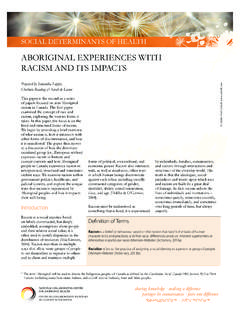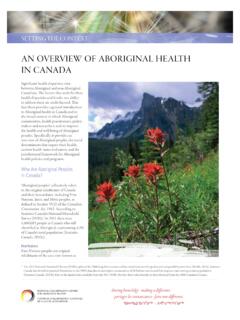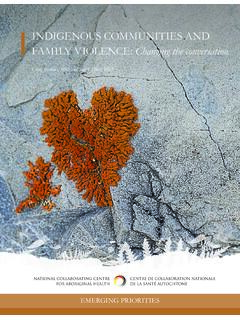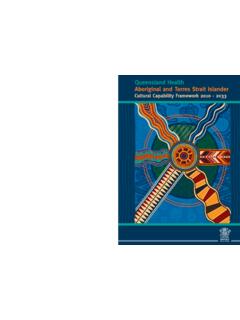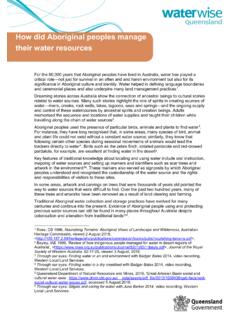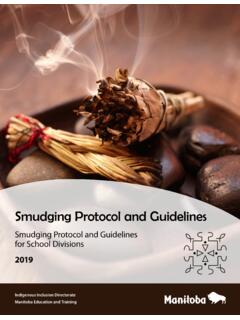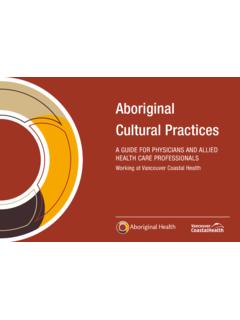Transcription of ABORIGINAL PEOPLES AND HISTORIC TRAUMA
1 ABORIGINAL PEOPLES and HISTORIC TRAUMA : The processes of intergenerational transmissionABORIGINAL PEOPLES AND HISTORIC TRAUMA : The processes of intergenerational transmissionSETTING THE CONTEXTW illiam Aguiar and Regine HalsethOuter Cover Photo Credit: , ID 41401420 Inner Cover Photo Credit: , ID 3340953 2015 National Collaborating Centre for ABORIGINAL Health (NCCAH). This publication was funded by the NCCAH and made possible through a financial contribution from the Public Health Agency of Canada. The views expressed herein do not necessarily represent the views of the Public Health Agency of paper could not have been completed without the invaluable assistance of Sharon Steinhauer, Diana Steinhauer, Sheila Poitras and Carmen Parent. The NCCAH uses an external blind review process for documents that are research based, involve literature reviews or knowledge synthesis, or undertake an assessment of knowledge gaps.
2 We would like to acknowledge our reviewers for their generous contributions of time and expertise to this manuscript. This publication is available for download at: All NCCAH materials are available free and can be reproduced in whole or in part with appropriate attribution and citation. All NCCAH materials are to be used solely for non-commercial purposes. To measure the impact of these materials, please inform us of their version fran aise est galement publi e sur le site , sous le titre Peuples autochtones et traumatisme historique: Les processus de transmission interg n : Aguiar, W. & Halseth, R. (2015). ABORIGINAL PEOPLES and HISTORIC TRAUMA : The processes of intergenerational transmission. Prince George, BC: National Collaborating Centre for ABORIGINAL further information or to obtain additional copies, please contact:National Collaborating Centre for ABORIGINAL Health3333 University WayPrince George, BC, V2N 4Z9 Tel: 250 960 5250 Fax: 250 960 5644 Email: 978-0-9952089-1-9 CONTENTS Download this publication at version fran aise est galement disponible au INTRODUCTION UNDERSTANDING TRAUMA THEORY AS IT RELATES TO ABORIGINAL PEOPLES IN CANADA Characteristics and patterns of behavior commonly found in TRAUMA victims that can contribute to the intergenerational transmission of TRAUMA The pathways by which TRAUMA can be transmitted through the generations ---------------------------------------- -----------------------------------12 Psychological processes.
3 12 Physiological processes ..14 Social processes .. CONCLUSION ---------------------------------------- -----------------------23 REFERENCES ---------------------------------------- -----------------------------25 Credit: Library and Archives Canada, ID PA-042133, Study time at Native residential school, (Fort) Resolution, NWT. The residential school era left ongoing and devastating impacts on the health and well-being of individuals, families, and communities. 5 ABORIGINAL PEOPLES and HISTORIC TRAUMA : The processes of intergenerational INTRODUCTIONThe current reconciliation process in Canada involving Aboriginal1 residential school survivors, their families, the Canadian government, and the churches is finally promoting awareness in Canadian society about the emotional costs ABORIGINAL families and communities have endured spanning a period of five generations.
4 Residential schools were designed to assimilate ABORIGINAL people into the dominant society through the forced removal of children from their families, communities and culture, and education oriented towards the dominant society s values, skills, culture, religion and language (LaFrance & Collins, 2003). The residential school era left ongoing and devastating impacts on the health and well-being of individuals, families, and communities. Residential schools eroded and undermined all aspects of well-being for ABORIGINAL PEOPLES through disruption of the structure, cohesion and quality of family life; loss of cultural identity; diminished parenting skills; and low self-esteem and self-concept problems (LaFrance & Collins, 2003; Rice & Snyder, 2008). These traumatic impacts have been felt not only by those with direct experience with residential schools they have also been transmitted to subsequent generations through various psychological, physiological and social processes.
5 The schools left an historical and emotional legacy of shame, loss, and self-hatred that is the root cause of addiction and many of the associated social problems facing ABORIGINAL communities today (Ross, 1996). Given the impacts this legacy of shame, loss, and self-hatred has had on the health and well-being of ABORIGINAL people , it is imperative that effective and culturally appropriate strategies be developed to interrupt the intergenerational transmission of this TRAUMA so that individuals, families and communities can begin to heal. This requires a better understanding of the processes by which TRAUMA can be transmitted through generations. This is the first of two papers focused on the intergenerational transmission of TRAUMA and will examine the various processes by which TRAUMA can be transmitted through the paper begins by providing an overview of the existing knowledge of TRAUMA , how it is defined, and how it must be conceptualized 1 The ABORIGINAL PEOPLES of Canada are defined, by Statistics Canada, as persons who reported identifying with at least one ABORIGINAL group, that is, North American Indian, M tis or Inuit [Eskimo]), and/or those who reported being a Treaty Indian or a Registered Indian as defined by the Indian Act of Canada, and/or who were members of an Indian Band or First Nation.
6 For the purposes of this report, ABORIGINAL PEOPLES refers to these three population groups: First Nations, M tis and Inuit, which is inclusive of those who are non-status Indians but who self-identify as First Nations or Please see the complementary report in this series Addressing the healing of ABORIGINAL adults and families within a community-owned college the context of ABORIGINAL people in Canada. This will be followed by a brief discussion about the characteristics and patterns of behaviour that are typical in ABORIGINAL families living with intergenerational TRAUMA . The paper then examines the psychological, physiological and social processes by which TRAUMA can be transmitted. The paper highlights the interconnectedness of these processes in transmitting TRAUMA through the generations and calls for holistic healing strategies that are implemented not only within the health domain but in other domains as well.
7 The second paper in this series2 explores the potential for healing strategies within the education domain, utilizing a case study of Blue Quills First Nations College (BQFNC) programs aimed at disrupting the intergenerational transmission of TRAUMA within families who are the descendants of survivors of Canada s residential school system. Credit: , ID 556006947 ABORIGINAL PEOPLES and HISTORIC TRAUMA : The processes of intergenerational UNDERSTANDING TRAUMA THEORY AS IT RELATES TO ABORIGINAL PEOPLES IN CANADA For ABORIGINAL PEOPLES , centuries of colonial policies and practices aimed at suppressing and undermining cultural identity while simultaneously assimilating children into Euro-Western culture through the residential school system have led to severe TRAUMA that is being passed through the generations (Ross, 1996). The many injustices and forms of oppression imposed by the Canadian government, especially the imposition of the residential school system, were explicitly intended to eradicate ABORIGINAL PEOPLES until there is not a single Indian in Canada that has not been absorbed into the body politic (Duncan Campbell Scott, Deputy Minister of Indian Affairs, 1920 as cited in Troniak, 2011, p.)
8 1). The TRAUMA experienced as a result of the residential school experience has built upon TRAUMA from earlier forms of injustice and oppression, and continues to be built upon by contemporary forms such that the TRAUMA is cumulative, with oppression and abuse becoming internalized, leading to a sense of shame and hopelessness that is transmitted and built upon through the generations (Duran, 2006). Over an extended period of time, the effects of this TRAUMA can reverberate throughout an entire population, resulting in a legacy of physical, psychological, and economic disparities that persist across generations (Sotero, 2006). Not only are individuals and families affected, but their communities are affected as well, resulting in responses such as social malaise, weakened social structures and high rates of suicide that become second-order effects (Evans-Campbell, 2008, p.
9 327). This chronic exposure to TRAUMA has manifested in individual symptoms such as anxiety, depression, grief, addictions, and self-destructive behaviours within generations of ABORIGINAL people (Bombay, Matheson, & Anisman, 2009). Addressing intergenerational TRAUMA has been an ongoing challenge for mental health professionals. A part of the problem is a failure to understand the connection between historical and contemporary TRAUMA in ABORIGINAL populations. This results in treatment approaches that tend to be pathologizing. They are directed at ameliorating the symptoms of the victims and so revolve around attempts to control the social world of the perpetrator (including incarceration) in order to minimize opportunities for acting out (Duran, 2006). Not surprisingly, these approaches have not been very effective to date. Understanding how TRAUMA theory relates to ABORIGINAL PEOPLES is necessary if we are to devise treatment approaches that are better suited to the unique context in which TRAUMA is experienced by ABORIGINAL individuals, families and communities.
10 This section will provide an overview of TRAUMA theory as it relates to ABORIGINAL populations. Western psychological frameworks posited for understanding the constellation of symptoms resulting from prolonged and repeated social and/or interpersonal TRAUMA revolve around diagnoses of post-traumatic 8stress disorder (PTSD) and complex post-traumatic stress disorder3 (CPTSD). PTSD is triggered by extreme stressors that have the capacity to provoke fear, helplessness or horror in response to the threat of injury or death (Yehuda, 2002). Symptoms typically include re-experiencing of the event ( flashbacks, distressing images, nightmares), avoidance of reminders of the event, and hyperarousal (which can be manifested in physiological conditions such as insomnia, irritability, impaired concentration, hypervigilance, and increased startle reactions) (Yehuda, 2002).


